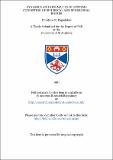Files in this item
Dynamics and kinematics of systems consisting of spherical and spheroidal bodies
Item metadata
| dc.contributor.advisor | Carson, T. R. (Thomas Richard) | |
| dc.contributor.advisor | Slebarski, T. B. | |
| dc.contributor.author | Papadakos, Dimitrios N. | |
| dc.coverage.spatial | 312 p. | en_US |
| dc.date.accessioned | 2018-06-20T13:37:52Z | |
| dc.date.available | 2018-06-20T13:37:52Z | |
| dc.date.issued | 1981 | |
| dc.identifier.uri | https://hdl.handle.net/10023/14346 | |
| dc.description.abstract | There are three principal aims of this work; firstly to derive the analytical expressions for the potential energy and the mutual gravitational attraction between two homogeneous or non-homogeneous oblate spheroids with coplanar equatorial planes; secondly, to construct and study the equations of motion of dynamical systems consisting of particles and rigid homogeneous spheroidal bodies whose equatorial planes are coplanar; thirdly, to investigate by numerical integration and compare the evolution of dynamical models of interacting galaxies. Two different types of dynamical models of galaxies were used in this work:(a) galaxies consisting of gravitating particles, (b) galaxies comprising of gravitationally interacting particles and heavy central rigid homogeneous oblate spheroids. Chapter (2) and appendices (4), (5), (6) and (7) are an account of the method used to derive the expressions for the potential energy and the mutual gravitational attraction between two rigid bodies bounded by spheroidal surfaces with coplanar equatorial planes, when the densities of the bodj.es are either constant or inversely proportional to the square of the radial distance from the centres of the bodies. These expressions were at first obtained in the form of non-elementary integrals over the complete elliptic integrals of the first and second kind, a result due to the fact that the common volume between two ellipsoids cannot be expressed in finite terms. The evaluation of these integrals was achieved with the aid of MacLaurin' s theorem by collapsing one of the spheroids to its confocal disc; their final form is that of rapidly convergent series in terms of the parameters which determine the shape and orientation of the spheroids. In the course of obtaining the expressions mentioned above we derived some other useful formulae, for example, the formulae giving the gravitational attraction between two homoeoids and the potential and force law of a non-homogeneous oblate spheroid. Having found the expressions for the gravitational potential and attraction between two spheroids we proceeded by constructing and solving the equations of motion of dynamical systems consisting of either particles or particles and rigid homogeneous oblate spheroids with coplanar equatorial planes [chapters (1) and (3), appendices (2) and (3)]. The solutions of the equations of motion - being non-algebraic - were obtained in the form of power series. In particular, for the first type of dynamical systems (particles only) they were found in the form of three different types of series. The first type is based on the development and implementation of generalized f and g series for the N-body problem, the second type is based on recurrent formulae used for the evaluation of the terms of the series and the last type of series is a power series in terms of ln ɼijτ/ɼij and polynomial of ɼijτ/ɼij. All the series mentioned above lend themselves easily, to numerical calculations since their convergence, which was analytically proved, is a rapid one. We concluded the present work by numerically integrating the equations of motion of dynamical models of pairs of interacting galaxies. The galaxies were of the types (a) and (b) mentioned previously. The numerical integration was performed with variable time steps in order to reduce computing time. A general method was developed for the precise evaluation of the length of the time step determined by the desired integration accuracy. The calculations were carried out to an extremely high degree of accuracy. The most significant of the results of the numerical experiments on the evolution of dynamical models of interacting galaxies were:(i) the development of long-lived spiral structure when galaxies of type (b) were lased even for intrinsic velocities and impact parameters so high that galaxies of type (a) were unable to produce such structure,(ii) the roughly periodic appearance and disappearance of the spiral structure,(iii) the fact that in the early stages of their evolution the dynamical models take up rather long-lived triaxial ellipsoidal shapes. | en_US |
| dc.language.iso | en | en_US |
| dc.publisher | University of St Andrews | |
| dc.subject.lcc | QB807.P2 | |
| dc.subject.lcsh | Astrometry | en |
| dc.title | Dynamics and kinematics of systems consisting of spherical and spheroidal bodies | en_US |
| dc.type | Thesis | en_US |
| dc.contributor.sponsor | University of St Andrews | en_US |
| dc.type.qualificationlevel | Doctoral | en_US |
| dc.type.qualificationname | PhD Doctor of Philosophy | en_US |
| dc.publisher.institution | The University of St Andrews | en_US |
| dc.publisher.department | St Andrews University Observatory | en_US |
This item appears in the following Collection(s)
Items in the St Andrews Research Repository are protected by copyright, with all rights reserved, unless otherwise indicated.

